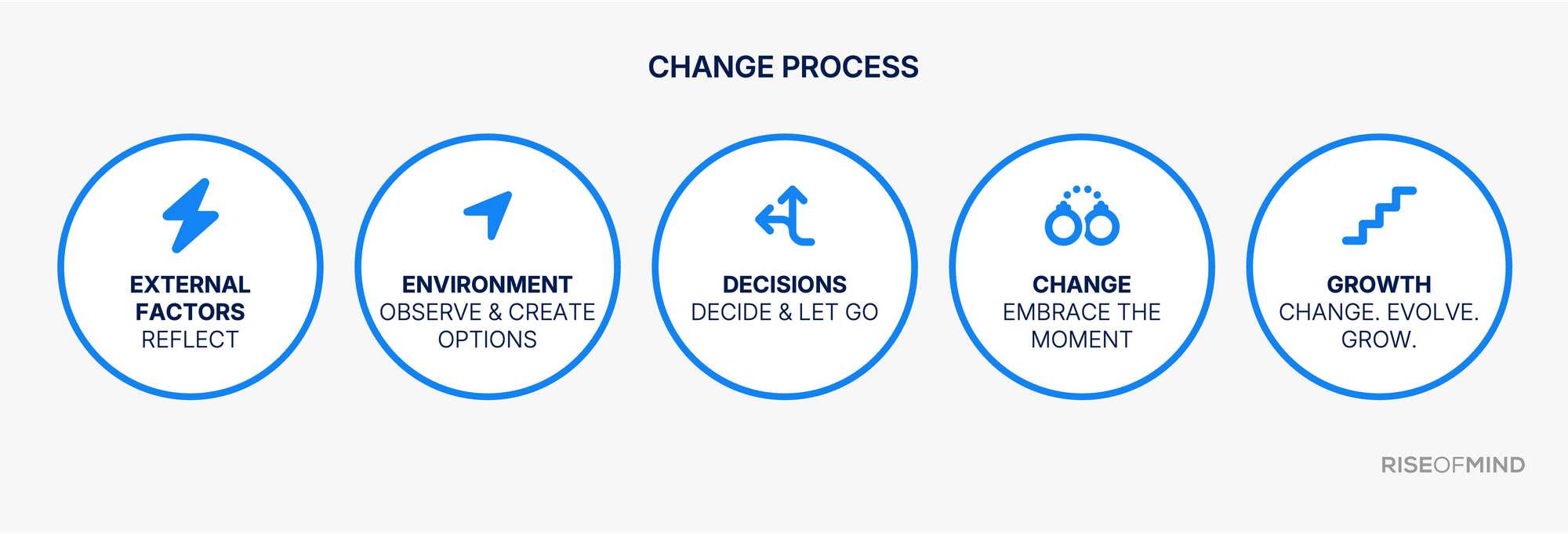Change affects all of us - sometimes it creeps in quietly, sometimes it hits us unexpectedly. Whether at work, in relationships, or in everyday life: eventually, you reach a point where it becomes clear that things cannot stay the same. But why is it often so difficult to actively embrace change?
Uncertainty on the path of change: Why we hesitate
Change always brings uncertainty.
Even when the current situation feels unsatisfying, it still seems more controllable than the unknown. This fear of uncertainty can be paralyzing - and causes us to miss out on opportunities hidden in new beginnings.
That’s why it is essential not to leave change to external circumstances, but to take it into your own hands. The 5 pillars of change model helps you design the process step by step - consciously and with clarity.
The five pillars of your change process

1. Identify triggers - the starting point of every change
Every change is preceded by a trigger. This may come from the outside, such as career shifts, technological developments, or personal decisions in your environment. It may also arise from within, when you realize that your current situation no longer aligns with your goals and values. Recognizing and reflecting on these signals creates the foundation for actively shaping change.
2. Assess your environment - develop a strategy
Change is not driven by motivation alone. It requires a strategy:
- Create options: what alternatives are available to you?
- Check resources: which strengths, skills, and networks can you leverage?
- Analyze your environment: what opportunities and risks come from your context?
- Set priorities: which steps will have the greatest short-, medium-, and long-term impact?
A clear strategy reduces uncertainty, provides orientation, and makes decision-making easier.
3. Make decisions - let go
Change also means leaving behind familiar certainties. The decisive step happens when you take action despite uncertainty. Courage shows itself in realistically assessing risks while still taking responsibility for your next move. It also means letting go of outdated routines, ingrained patterns, or role expectations that limit you.
Here, the connection between courage and resilience becomes clear: those who view setbacks not as failures but as opportunities to learn gain flexibility and inner strength.
4. Feel the relief - the power of first steps
Once you implement initial changes, a tangible effect sets in: burdens fall away, energy is released, and new perspectives open up. This momentum is crucial, as it proves that change is truly possible. Even small progress becomes a source of motivation to continue and solidify your chosen path.
5. Experience growth - strengthen competence and confidence
Every successfully managed step of change enhances your ability to act. You build new skills, increase self-confidence, and broaden your perspective. At the same time, you gain valuable experience in handling uncertainty and navigating transitions. In this way, change transforms from a threat into a powerful tool – opening up new options and fueling both personal and professional growth.
Your toolbox for successful change
In upcoming articles, you’ll find practical insights and hands-on tools to help you approach change in a structured way:
- Methods to manage uncertainty and fear
- Strategies to strengthen decision-making skills
- Tools for planning and implementing change steps
Change is closely tied to effective self-management. Those who steer themselves with reflection and clarity strengthen resilience and lay the foundation for lasting success and satisfaction - in both professional and personal life.
The next step: Actively shaping change
Every change begins with a clear decision: to stop merely reacting and start leading the way. That means setting priorities consciously, spotting opportunities, and tackling challenges step by step.
Join the RiseOfMind community and get proven tools for personal growth, practical change management strategies, and effective methods for overcoming uncertainty. Shape change intentionally with focus, clarity, and long-term impact.

